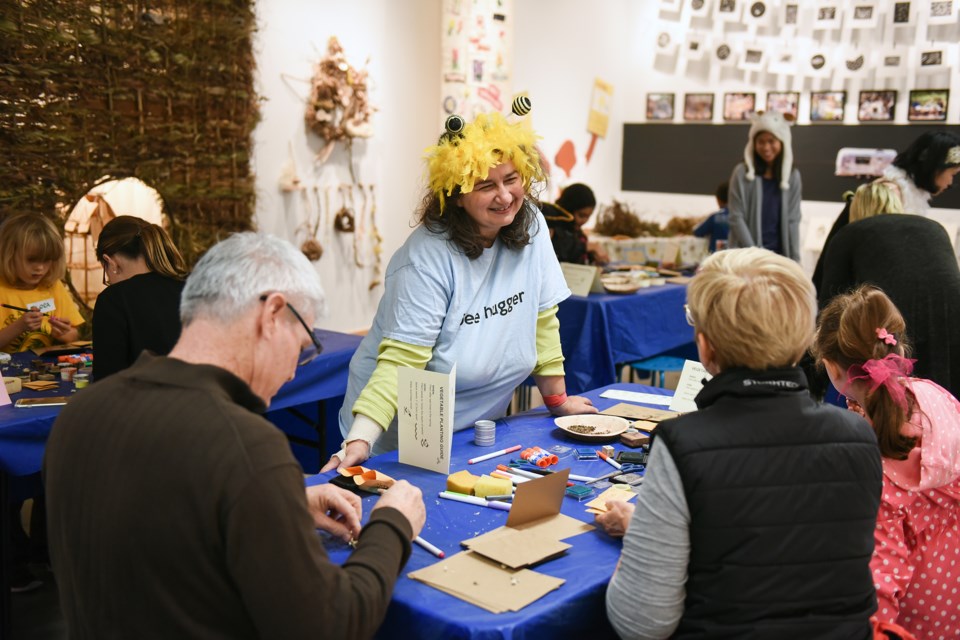To bee or not to bee is simply not a question for Lori Weidenhammer.
Better known as âMadame Beespeakerâ to her young Seeds for Bees! workshop students at ArtStarts Gallery this past weekend, Weidenhammer loves talking bees with kids.
âI am very passionate about sharing my love of gardening with children through hands-on eco-art activities. Itâs my passion, my hope, when I see kids connecting with bees because thatâs going to save our future â and their future,â she said before Saturdayâs workshop. âI fall in love with them.â
Easy to see why, especially when students such as six-year-old Flora Graham â who wore all yellow for the occasion â listened with so much concentration that her mouth hung open while absorbing instructions on how to make seed pods using rocky mountain bee plant seeds brought in from Weidenhammerâs own Â鶹´«Ã½Ó³»backyard.
It was during those early years when Weidenhammer herself became interested in bees and the vital role they play in food production. She grew up in tiny Cactus Lake, Sask. where dad owned a general store and mom tended a beautiful garden. Beyond the colour burst of Prairie wildflowers were the wheat fields that looked like they touched the edge of the horizon.
âMy parents were really great about teaching me about the natural Prairie because thereâs not much left,â Weidenhammer said. âItâs an untold story. People know about saving the rainforest, but they donât know thereâs very little natural Prairie left and those wildflowers are what support a lot of native bumblebees.â
Almost 95 per cent of the Prairies have been converted to cropland and, with that, wildflowers are not nearly as plentiful as they once were. Which is why, Weidenhammer said, itâs so important to teach people not only where their food comes from, but also to show how they can help repair some of the damage.
âWe need to give back to the bees so we need to plant more flowers around our fields,â she said. âWe need to protect the flowers, the natural wildflowers that are there, and we need to dig up our lawns and plant flowers for the bees.
Flowers need bees and bees need flowers.â
Weidenhammer, whose background includes singing, art and performance, apprenticed under local master beekeeper Brian Campbell. Intensive study led to so much information she could fill a book (which is exactly what she did with next springâs release titled A DIY Guide to Saving the Bees, through Douglas and MacIntyre).
One of the many interesting facts she covers includes the need to shift focus to the native bee from the honeybee.
âSorry to say but thereâs an inconvenient truth going around that we need to save the honeybee. Itâs actually the native bees that need to be saved,â said Weidenhammer, who acknowledged that while she loves all bees, honeybees included, the native bee â which requires native plants to survive â is vanishing at a faster rate than honeybees. A frightening fact, especially given there are more than 970 species of native bees in Canada.
The gentle native bees are said to be two to three times better pollinators than honeybees, which are more interested in nectar while native bees collect pollen to take to their nests. Crops, such as tomatoes, blueberries, cranberries, squash and alfalfa, are better pollinated by native bee species, which include the carpenter bee and Morrisonâs bumblebees.
Between loss of habitat and use of dangerous neonicotinoids pesticides, bees are suffering, which will have disastrous effect on both agriculture and environment. Thatâs why Weidenhammer is keen to make a difference by way of education.
âOnce I gave a little boy a plant and he said, âOK, but can you actually put it in the soil because I donât want to touch it,ââ she recalled. âThat was the saddest thing Iâve ever heard. My mission is to get the kids planting the seeds and touching the soil. Once theyâre in there, they often get hooked.â
@rebeccablissett



